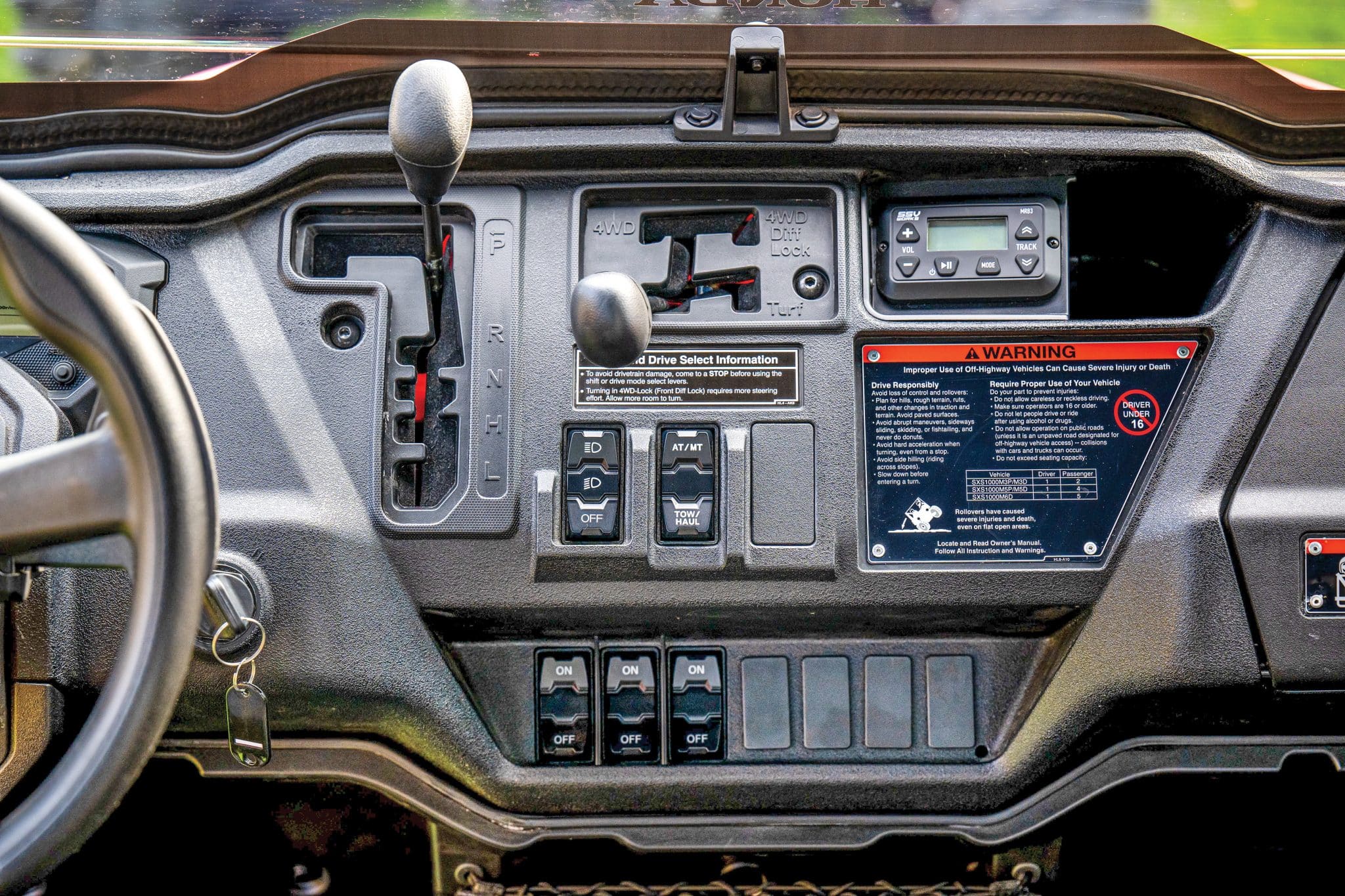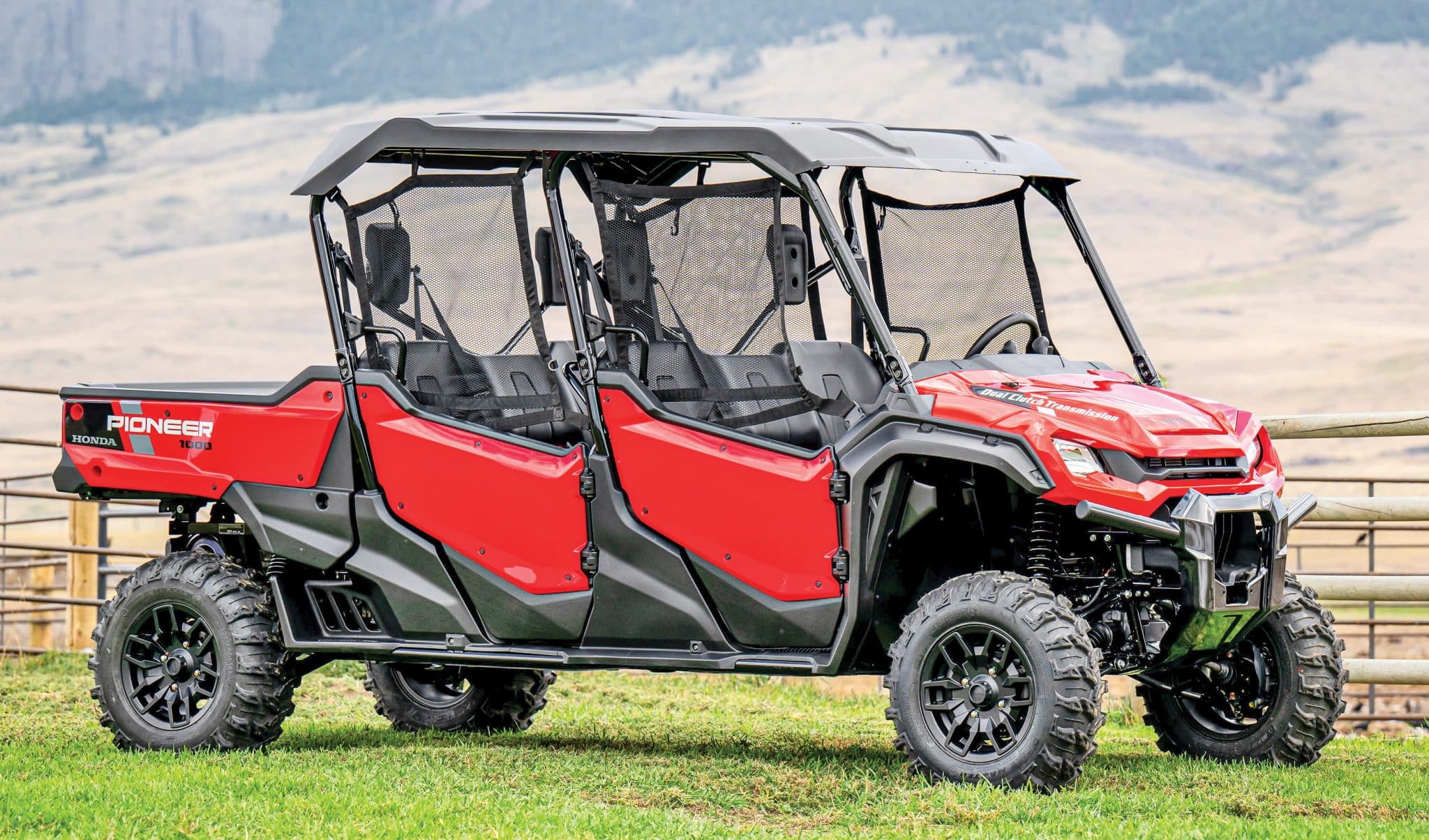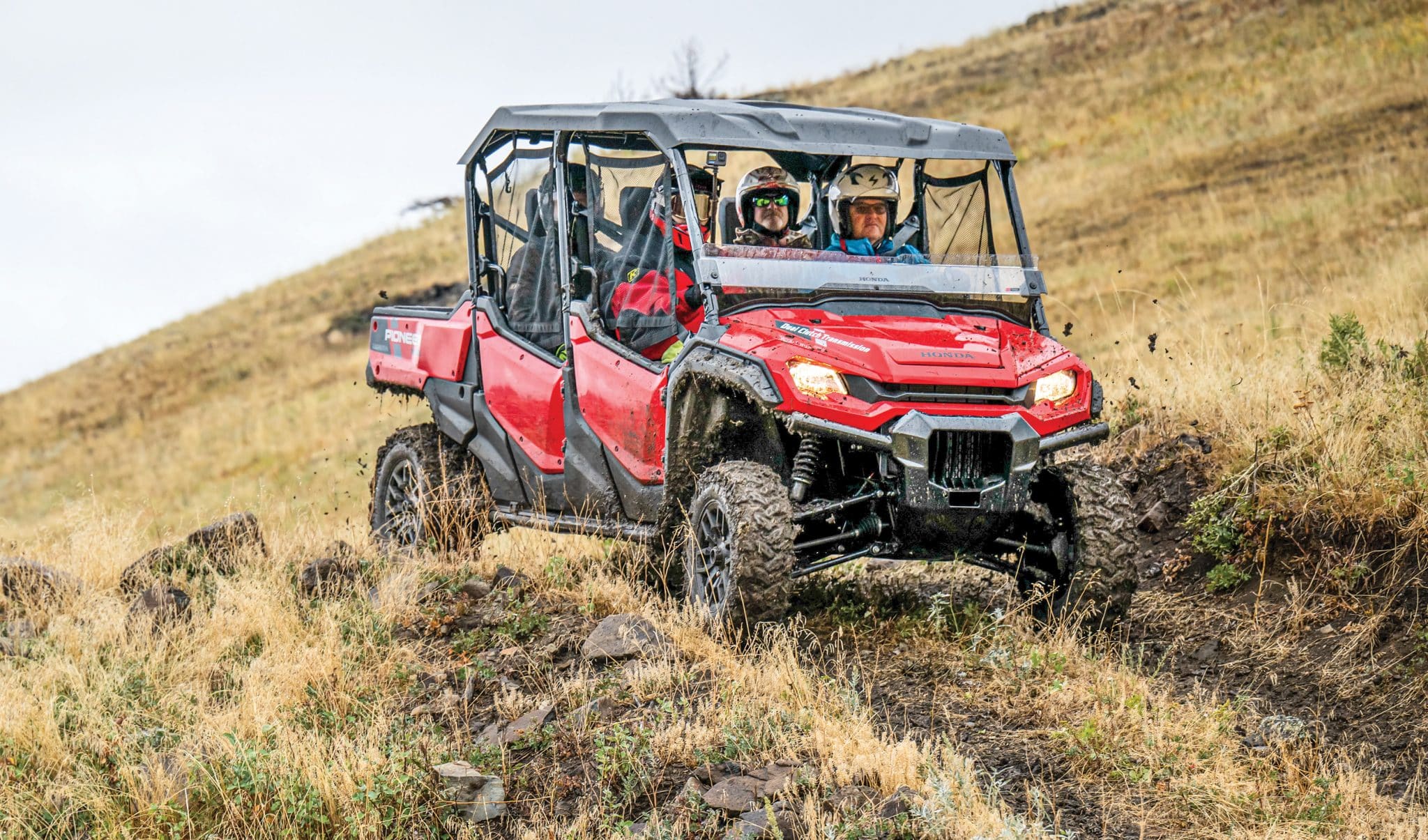UTV TEST: 2023 HONDA PIONEER 1000-6 DELUXE CREW
Room for everybody (dibs on the back seat!)
By the staff of Dirt Wheels

The official model release for the Honda Pioneer 1000-6 Deluxe Crew six-seater was held at the Bull Run Ranch near Great Falls, Montana. This amazing working cattle ranch was the perfect location for our first experience with the long-wheelbase, four-door, six-seat Pioneer 1000. It was once an off-road destination ribboned with a complete trail system engineered to NOHVCC guidelines but is no longer open to the public. For a UTV straddling the fence between work and recreation, it doesn’t get any better.
It is easy to assume that long-travel turbocharged performance UTVs dominate sales. They do dominate racing and advertising, but not sales numbers. Models with dump beds and enough performance to make recreation use a reality make up the majority of UTV sales. Honda further revealed that a full 25 percent of units we refer to as rec-utility machines are four-door crew cabs with seating for four, five or six passengers.
Relatively few rec-utility UTV owners reserve the machine for a single purpose. It may reward owners with trail fun, camping, hunting or fishing, but it justifies the expense of ownership plowing snow, moving feed, dealing with irrigation or assorted other tasks. Bull Run’s 15,000 acres is crisscrossed with maintained and engineered tracks. Few are wide enough to be comfortable in a full-size truck, so Bull Run was literally home on the range for the Pioneer 1000-6. We were lucky enough to have Mother Nature’s assistance with the dust-control chores, and she gave us both tacky soil and slippery, slimy mud sections that put traction capabilities to the test!

MAKING ROOM FOR SIX
When building the Honda Pioneer 1000-5 Honda kept it a masterpiece of compact design with two rear passenger seats that pull up from the bed floor. That choice kept the footprint of the 1000 and the 1000-5 quite similar. Once the choice was made to abandon a compact wheelbase, why not go full trail limo? Honda began by adding a whopping 35-inches to the wheelbase!
That’s enough room to have another full contoured bench seat in the rear and the most legroom in the class. We have never before heard tall passengers calling, “Dibs!”, on the rear seat of a UTV. If they trust the driver, our tall guys want the back seat. The front seat is fine, but it can’t touch the rear’s comfort and legroom.
The change didn’t come down to welding in some pipe. Honda builds a strong frame (we’ve seen the factory’s durability testing for the 1000-5), but Honda found key bending points for the 1000-6 chassis needed to be three times stronger than the shorter-wheelbase machine! Honda included a line drawing of the frame with the strengthened sections in blue; it was almost all blue.
Honda was able to share many other parts. The suspension components and travel numbers, brakes, wheels, and tires are all shared with other Pioneers. The springs for the self-leveling suspension must be somewhat stiffer. The crew cab is designed to carry more people and a full bed load of up to 1000 pounds. Compared to the Pioneer three-seater, the Crew is 341 pounds heavier, but the Pioneer 1000-5 is only 163 pounds lighter since it includes the hidden rear seats. To us, it even looks like the front and rear doors are the same, as is the dump bed identical to the Pioneer 1000. That is just sound engineering in our minds. Why reinvent when you already have perfectly good parts available.

MOTIVATION STUFF
For 2022 Honda gave Pioneer 1000 Trail and Forest models more power in the middle and upper rpm ranges, thanks to revised valve timing and an updated throttle-body plate setting. New to the 2023 Crew Cab is a tow/haul mode that holds a gear longer and shifts smoother. Tow/haul can be used in low or high range. Towing capacity is up to 2500 pounds with the added performance. Cooling fan size has been increased correspondingly.
All 2022 Pioneer 1000 versions received updated gear ratios that are wider overall, with more pulling power at lower speeds. Now that the 1000-6 is here, we see the reason for the ratio change. Without the older Pioneer to compare directly, we didn’t notice the ratio change, but we did notice and appreciate the improved shifting action, with reduced shock during gear changes. Shifting is further improved for the Deluxe Crew, and more so in tow/haul mode.

THE OTHER POWER
The Pioneer Deluxe Crew, like the 2022 models, all have a pre-wired panel under the hood to simplify installation of electronic accessories. That isn’t all the electrical news. The 1000-6 has a 12-volt accessory receptacle in the bed to power 12-volt devices, as well as a cargo light in the bed.

INSIDE JOB
The first thing that you’ll notice is that the Deluxe Crew is long! You’d naturally think that it doesn’t turn very tight but it’s quite agile. Honda claims that it has an 18.7-foot turning radius, and out on the trail, it negotiated all but the very tightest of turns. A sharp eye will also spy a 63-inch width, and that is measured at the wheel flares. The track width is somewhat narrower. Given the intended buyer, the width is spot-on.
In fact, the trails that we were navigating weren’t much wider than the car. Anything wider would have had some precarious moments on the numerous “cliffy” sections! The chassis was very stable, even loaded up with four full-sized adults. It didn’t display any undesirable handling traits regardless of the pace! It stayed flat in the turns with no abnormal body roll, and the wheelbase kept the rear end in line.
The suspension provides 10.5 inches of front wheel travel and 10 inches in the rear, and is tuned well for this vehicle. We must admit that Bull Run routes provided little to tax the suspension. Part of this is due to a clever rear suspension design that employs hydraulically assisted shocks that automatically keep the vehicle level regardless of load.

STEERING
Honda redesigned the EPS in 2022 with 50-percent more torque assist and an automotive-type return-to-center steering rack. At lower trail speeds, the steering was easy and responsive, with just the right amount of power assist. The Pioneer has a higher-ratio (more turns lock to lock) steering box than sport UTVs. After a few minutes we didn’t even think about it while driving. The steering wheel is nicely shaped and comfortable to grip, and the paddle-shifting levers are within easy reach. The tilt function, though not telescoping, provides enough movement to satisfy even the largest pilots.
All of the vehicle’s controls are located smartly on the dash within easy reach of the driver’s right hand, and our demo rig had an optional (Honda accessory) half windshield and a Bluetooth stereo installed. Up in front of the dash, under the easy-open (tool-less) hood, you’ll find easy access to the brake master cylinder reservoir, radiator cap and overflow tank. Another nice feature was a wiring harness that made adding any (Honda) electrical accessory an easy task, with wiring connectors already installed and capped.
Inside, just below the dash on the passenger’s side, is another storage “shelf” with cargo net-type webbing to help with your gear. With this style of vehicle, the driver and front passenger are practically on top of the front axle, so the driver’s left foot, and the passenger’s right foot have a little less room in the foot wells. The gas and brake pedals are further forward and provide a comfortable position while driving.
Speaking of brake pedals, this one isn’t going to get that much use. We’re talking about engine braking here! The Pioneer’s available engine braking is one of the stand-out features, especially if you are in low range with the tow/haul mode engaged! With a car full of people, in low range, using the brakes will only be required on the steepest of descents! We found ourselves modulating the amount of engine braking with the throttle. A smooth and steady gas-pedal foot can produce a seamless ride going downhill.
Another benefit of this Honda transmission is the fact that it is a 6-speed. Bull Run’s routes are narrow with few straight sections a frequent precipitous drops on one side of the trail. High speed isn’t a smart option. To be honest, we could have driven the entire time in either high or low range; the six speeds make it that versatile. We never ran out of available speed running in low range!

In high range, first gear is low enough for most any situation, but we often selected low range for snappier acceleration and less load on the DCT clutches. In addition to low and high, the Pioneer features the ability to be in 2WD, 4WD, 4WD front diff-lock, and 1WD (turf mode) so you won’t tear up anyone’s nice lawn. Driving a machine with the front differential locked often results in a bucking sensation in the tighter corners, but that was not the case. You could tell that the front was getting distributed power but with no ill consequences!
Another novel feature of this latest version is the staggered seating arrangement. The middle seats in both the front and rear rows were set slightly ahead of the two outside seats. This puts the shoulders of the people riding center seat to be just ahead of the outer passengers, and thus reduces shoulder-to-shoulder contact while riding.
The seats are comfortable, and putting in long hours won’t be a problem. The front and rear seat bottoms are one piece and are easily opened and removed via a lever located in the center just below the cushion. This gives the occupants six spaces to stow cargo inside the vehicle. The rear seating arrangements provide a huge amount of legroom. Our passengers over 6 feet preferred the rear seat!
Another smart design feature is the placement of the cargo bed’s dump actuation lever. You must open the rear door to gain access to the dump lever. This eliminates snagging the lever on any passing items. With the bed in the raised position, access to the mid-mounted engine should make maintenance easy.
This is a well-thought-out machine. The design and R&D teams have worked well together on this product! The last item that comes to mind is the simple roof design. It is a one-piece design that has quick-release fasteners, and it works well. It doesn’t come stock on the Deluxe Crew, but we wouldn’t want to drive without it. We had intermittent rain during our testing and were grateful for the roof addition. If you have a ranch, or a requirement to haul a crew around, this machine should be at the top of your shopping list. We proved it can handle the fun after work hours!
2023 HONDA PIONEER 1000-6 DELUXE CREW
Engine type Liquid-cooled, four-stroke, four-valve, Unicam parallel-twin
Displacement 999cc
Bore x stroke 92.0mm x 75.15mm
Fuel system EFI
Fuel capacity 7.9 gal.
Starting system Electric
Final drive Automatic DCT w/ 6 speeds, reverse and high/low; drive modes include 2WD, 4WD, Turf, 4WD w/ differential lock
Suspension/wheel travel:
Front Double wishbone/10.5”
Rear Double wishbone/10.0”
Tires:
Front OTR Dirt Master 27×9-14
Rear OTR Dirt Master 27×11-14
Brakes:
Front Hydraulic w/ (2) 210mm discs
Rear Hydraulic w/ (2) 210mm disc Wheelbase 115.2 in
Length/width/height 152.2”/63”/76.1”
Ground clearance 12.6”
Payload capacity 1000 lb. (600 lb. for CA models)
Towing capacity 2,500 lb.
Curb weight 1,936 lb. (wet)
Colors Red, olive, Honda Phantom Camo
MSRP $21,899; $22,699, Honda Phantom Camo




Comments are closed, but trackbacks and pingbacks are open.